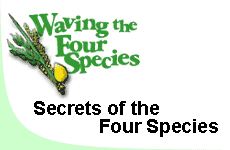 Iran’s Attack on Israel
Iran’s Attack on Israel


5 min read
The key to joy is success in our relationships. This includes our relationship with other people, with ourselves, and with God.
Every Jewish holiday is infused with a special energy to help us work on a particular character trait, and to develop certain aspects of our lives. The mitzvot of the holiday are tools to help us achieve the goal of the time.
Often, the key to discovering this focus is found in the prayers. The Siddur (prayer book) refers to Sukkot as Zman Simchateinu, "the Time of Our Joy." Sukkot is designed as a one-week workshop on joy!
For seven days, we move out of our wall-to-wall carpeted, air-conditioned house, into a little hut called a Sukkah. But how is this supposed to make us happy?!
The lesson is that the physical objects with which we surround ourselves are not what make us happy. A person can live in a gorgeous home and be absolutely miserable. Or, he can live in a shabby hut and be ecstatically happy. The key to joy is success in our relationships. This includes our relationship with other people, with ourselves, and with God.
The Lulav offers important clues on how to achieve joy through relationships. (Note that "Lulav" refers to the date palm leaf, but since it is the largest, the term refers also to all four species together.)
The Midrash says that the four species of the Lulav represent four different types of Jews:
On Sukkot, we gather these four species, bind them, and wave them all together. The Lulav is only kosher if all four species are taken together. If one of the species is missing, the entire Lulav is invalid.
A similar principle is taught by the composition of the incense brought in the Holy Temple. There were 11 ingredients, of which one, the chelbanah spice, smelled terrible. Yet, the incense was only valid if all the ingredients were included together. This teaches that we must look at all the Jewish people as a unit, working together.
There may be people we don't like, but we still have to deal with. We cannot simply say that certain people are not part of our world, or that they do not belong to us. On the contrary, humanity is one indivisible unit. This recognition is basic to happiness because when we realize that we are all interconnected, we can be more patient and tolerant of others.
Note that when the Lulav is held, the Esrog is held next to the willow. The one with the "most" should position himself to be near the one with the "least," in order to favorably influence him.
This idea finds expression also in the mitzvah of inviting guests into our Sukkah. This year, try inviting some friends over ― perhaps even someone who you don't know very well. The results will astound you!
Another way to look at the Lulav is mentioned in "Sefer Bahir," a kabbalistic work almost 2,000 years old. It describes the four species as four parts of a human being:
The four species must be taken together as a unit. So too, to achieve happiness, one must use all of his faculties in unison. You cannot say one thing and feel another. We must unify our feelings, our actions, our speech and our outlook. With all of these working together, we are well on the path to self-esteem, tranquility and joy.
The four species also represent the Name of God. Aravah (willow), Hadas (myrtle), Lulav (date palm) and Esrog represent the Yud and Heh and Vav and Heh of the four-letter Name of God.
Again, the key here is unity. As we say everyday in the Shema prayer: "God is One." Whether things may appear to us as good or evil, we must realize that it all comes from God. One must deal with various pleasant or unpleasant circumstances ― ultimately for one's maximal growth, but at the root everything comes from God.
Being aware of this keeps our focus and helps us to deal with the issues of life. When we relate to God's unity, we come closer to achieving joy in the world.
Sukkot is a one-week opportunity to build these relationships and incorporate them into our lives. May we all enjoy great success in this venture!
Sources:
"Sefer HaMinhagim" ― Chag HaSukkot I
"Midrash Rabba" ― Leviticus 30:12
Talmud ― Menachot 27a; "Code of Jewish Law" O.C. 651:12
Talmud ― Kritut 6a-b.
"Midrash Rabba" ― Leviticus 30:14.
"Chaim B'Yad" ― Rabbi Chaim Palatchi, 52
"Rav Pe'alim" ― Ben Ish Chai ― II Y.D. 32
